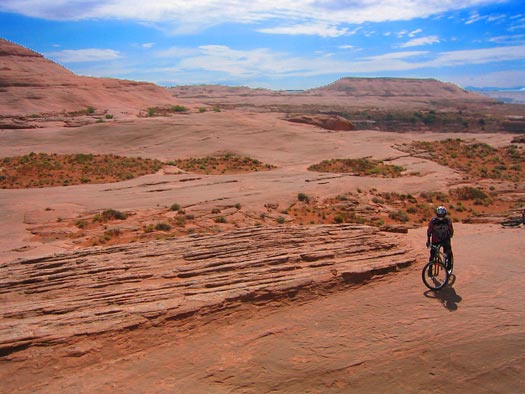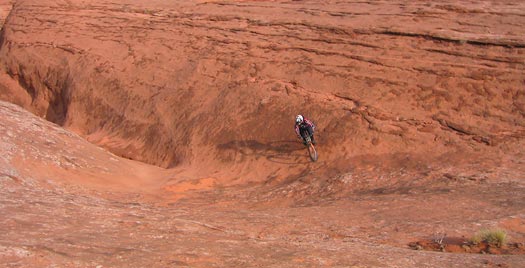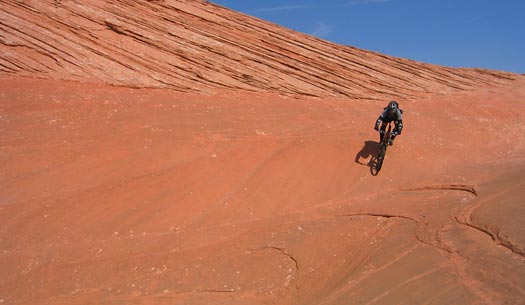
 Slickrock Riding Skills
Slickrock Riding Skills
First--SLICKROCK IS DANGEROUS! Now that you know that, taking a day to a week long clinic with Dreamride is the best way to get started in Moab to boost your skills to roost your buddies back home. The photography portions of these clinics are as rewarding as the skills lessons. Continuing with a Day Tour Series Vacation is the way to ride in RELATIVE safety as your skills improve in the most exotic locations imaginable. Dreamride offers a delicious variety of slickrock surfaced trails far superior to the traditional haunts. Dreamride has a special guide designated just for the Moab Slickrock Trail who will take you to special off-piste spots perfect for honing your skills. Dreamride guides have been riding the area over the past 15 years.
Dreamride scouts its exotic rides using a helicopter combined with follow up ground scouting. Dreamride does this for the film industry as well. Take advantage of this expertise with a SLICKWEEK VACATION.
 Scratching the Surface
Scratching the Surface
Getting started: Before you attempt the Moab Slickrock Trail, it is best to spend some time practicing the skills necessary to negotiate the steeps and transitions. There is a section for this designated as the Practice Loop, probably the best section of the entire trail due to its scenic location, variety of challenging sections, and close proximity to the parking lot. Spend some time here developing skills before you ride out onto the main trail. Also visit the Dreamride SAFETY PAGES for information on hydration and such. The tips below will be beneficial as well.
SANDSTONE SURFACES: Around Moab we have a number of varieties of sandstone to ride on. Dreamride offers photos and descriptions of, and day tours in SPECIAL SLICKROCK AREAS.
Navajo Sandstone trails such as the Moab Slickrock Trail and Poison Spider Mesa are the traditional haunts of the thousands of mountain bike tourists who come to Moab every season. There are also very nice Navajo Sandstone rides such as Monitor and Merrimac (sandy as hell, too) and more obscure routes known to a very few driven riders, such as the picture above taken in true Navajo country where the formation got its name. Navajo Sandstone is generally smooth and rolling due to its support by the Kayenta Sandstone layers beneath, which act much like mylar layers in a bullet proof vest, absorbing the weight of the Navajo with layer upon layer of thin, hard sandstone. The Navajo, as a result, is uniformly eroded by alternating desert sun and cold nights, causing it to "round off." The Navajo can be bumpy, but most of the time it is smooth and rolling, like a roller coaster ride with sand g-outs or water courses at the bottom of the most severe transitions. A special note on Navajo Sandstone: The lichens that inhabit the rock are not only fragile, but hold a small amount of moisture that freezes in low temperatures. It can be very dangerous to ride Navajo slickrock in winter! It is sort of the mountain bike equivalent of black ice.
The Moab Entrada Slickrock Tongue is the cream of slickrock surfaces in the area and comprises most of the rides in the Rainbow Rocks area and the off-limits psychedelic rollies in Arches National Park. It is comprised of a number of layers, the most wonderful of all being red to orange layers that are grippy as can be and smooth as a baby's butt. These layers are riddled with holes called solution pockets that make for some pretty challenging obsticles. There are deeper red layers that are thin and very bumpy, but also very grippy. There are also greenish layers that are downright dangerous, slippery when dry, snot slimy when wet. The Entrada is home to dangerous dropoffs and vertical exposure, as with the Navajo, but Entrada rides generally require a faith in your skills and equipment that is tantamount to religion.
The Rico and Moencopi layers are home to some of the some gritty sandpaper rides, but at Dreamride we know of no other bikers who ride these layers. We have a couple of spots where these almost purple layers present riders with the opportunity to ride in solitude, see a petrified forest, and maybe take off a couple of layers of skin. Dreamride is the only tour company to hold a permit, or even know about, this particular area.
There are other ridable slickrock layers, like the top of the ledgy Kayenta, the cap of the Morrison, and some portions of the Wingate, but the layers mentioned above will keep us busy enough for now.
 The Skills
The Skills
Climbing on slickrock: Before you go down, you gotta go up, and slickrock is an awesome surface to climb. Because tires stick to it like glue you can climb anything as long as you can keep your front tire on the ground. Steep grades require that you shift down to your granny, stand on your pedals, lean way out over the handlebars (kiss the front tire, if you can), and maintain a smooth and powerful pedal stroke. Zig-zagging up a steep slope is sometimes necessary to cut the hill down to size. Strength and skills in weighting the bike are the two most important factors in conquering technical slickrock, along with equipment. You need some low gears, hubs that don't blow up, and suspension helps. Don't give up, and don't worry about your rear tire breaking loose, unless the rock is wet or you are using those Michelin green tires that really suck on rock. Bar ends help, but can be dangerous if you choose to abort in mid-climb. You've got to be able to grab those brakes to keep from rolling backward! Running out of steam, coming unpeeled (wheelie over), and hitting a patch of sand on the rock, all mean defeat, and maybe some road rash. Worst things can happen, too. Vertical exposure is often an element of the ride.
Descending on slickrock: As you roll over the top of your climb check the downside. Look before you leap. Keep your weight way back on steep descents, like you are trying to wipe your ass with your rear tire. Practice this skill on the flats before you try it on a steep section of trail. You need to be able to cleanly clear the saddle and swing back behind it without snagging your shorts or wobbling. A good practice is to swing back over the rear tire and while in the most extreme position, try to stop the bike with your ass on the tire. Be gentle and lower yourself until you barely touch the knobs. This takes a bit of leg strength. While you are back there try turning the bike in a circle. Swing up and back, up and back, until it is a smooth motion that does not effect your line. Once you have developed this skill to the point where you can do these stunts, you will be able to negotiate the scariest downs. Keeping your weight back means that you avoid the two worst things that can happen; an endo or a side slide out. Not pretty! The injury of choice on slickrock is a broken hip caused by using too much rear brake and not weighting it properly. USE EVEN BRAKING. The front brake is your best friend. If you are behind the saddle on a downhill, both brakes grab. If your wheels are slipping, you ain't doing it right. If you go over the bars, you weren't far enough back. Remember: You do not want to fall on slickrock! Ever!
 Transitions: At the bottom of the steeps are abrupt rock g-outs and deep sand. Hit the transition with your weight in the wrong place and you will endo or loose control needed to steer up the next section. Momentum and weight shifts facilitate clean transitions. Gearing is usually set to come on solid on the upside, while gravity will control your speed and momentum on the downside. Only experience will show you just what gear to grab BEFORE you head down. You want to be in the right gear before the transition. Some riders prefer the middle ring and largest cog in the rear, others want that granny gear, but it is always a judgment call to maintain speed and momentum. As you reach the bottom release your brakes to gain the needed momentum. This is tricky because varying degrees of steepness of the downslope and upslope and the severity of the transition necessitate varying speed and braking. Some transitions on slickrock will have deep cuts at the very bottom made by water erosion. These require attention. Brake release is always a bit different for each transition situation, but generally you will release the front first and using the rear to feather your momentum into and through the transition. Watch for bits of sand on the upslope and if the sand at the bottom of the transition is wet, WATCH OUT. It will stick to your tire and traction will vanish when you throw on the horsepower. Front braking in a sandy transition is not a good idea at all. As you enter the transition your weight will still be at the back of the bike. As your front wheel reaches the bottom of the hill keep the weight back, shifting forward with the transition. This is the dangerous point and you should practice on easy transitions and work your way up to the steeps. Speed is your friend on some transitions where momentum can carry you out of the gully, but on severe and steep transitions speed can combine with poor weighting to throw you out of control at the most crucial point. Throw sand into the equation and you have the makings of high comedy and maybe severe Search and Rescue tragedy. Read the SAND SKILLS SECTION to gain understanding of how to deal with deep sand in these transitions. Digging that rear tire in at the right moment makes all the difference. Once you are on rock again the wheel will bite hard if there is no loose sand on the rock and your tire is not carrying wet sand. In the sand don't give up! Stay upright and pump away until your rear tire hits rock. As you begin your ascent and momentum slows, shift your weight over the front of the bike and utilize climbing skills to get out.
Transitions: At the bottom of the steeps are abrupt rock g-outs and deep sand. Hit the transition with your weight in the wrong place and you will endo or loose control needed to steer up the next section. Momentum and weight shifts facilitate clean transitions. Gearing is usually set to come on solid on the upside, while gravity will control your speed and momentum on the downside. Only experience will show you just what gear to grab BEFORE you head down. You want to be in the right gear before the transition. Some riders prefer the middle ring and largest cog in the rear, others want that granny gear, but it is always a judgment call to maintain speed and momentum. As you reach the bottom release your brakes to gain the needed momentum. This is tricky because varying degrees of steepness of the downslope and upslope and the severity of the transition necessitate varying speed and braking. Some transitions on slickrock will have deep cuts at the very bottom made by water erosion. These require attention. Brake release is always a bit different for each transition situation, but generally you will release the front first and using the rear to feather your momentum into and through the transition. Watch for bits of sand on the upslope and if the sand at the bottom of the transition is wet, WATCH OUT. It will stick to your tire and traction will vanish when you throw on the horsepower. Front braking in a sandy transition is not a good idea at all. As you enter the transition your weight will still be at the back of the bike. As your front wheel reaches the bottom of the hill keep the weight back, shifting forward with the transition. This is the dangerous point and you should practice on easy transitions and work your way up to the steeps. Speed is your friend on some transitions where momentum can carry you out of the gully, but on severe and steep transitions speed can combine with poor weighting to throw you out of control at the most crucial point. Throw sand into the equation and you have the makings of high comedy and maybe severe Search and Rescue tragedy. Read the SAND SKILLS SECTION to gain understanding of how to deal with deep sand in these transitions. Digging that rear tire in at the right moment makes all the difference. Once you are on rock again the wheel will bite hard if there is no loose sand on the rock and your tire is not carrying wet sand. In the sand don't give up! Stay upright and pump away until your rear tire hits rock. As you begin your ascent and momentum slows, shift your weight over the front of the bike and utilize climbing skills to get out.
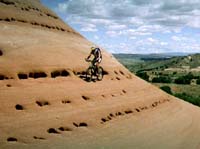 Sidehills: Of all slickrock skills, this is the most important due to the fact that while performing it you are usually in a situation that is most extreme. Imagine riding on the outside of a basketball. Think about it--a negative berm with a drop-off on one side as high as 200 feet. The good news is that you have lots of traction. The bad news is that momentum can sometimes be your worst enemy. Banging that inside pedal is right out, and clipping out on the downhill side can mean death and/or dismemberment. The first rule is stay relaxed. Next, you must pedal with a very even stroke. You do not want to cause your tires to break loose in the least. On some sidehills you can abort by diving down and off the hill, but sometimes this is obviously impossible. Concentrate on the surface ahead and avoid solution pockets, those swiss cheese holes in the rock, and especially avoid the greener slickrock layers. An advanced skill is to lean the bike out from the hill while remaining over the contact patch on the inside. Look for tiny ledges that you can
Sidehills: Of all slickrock skills, this is the most important due to the fact that while performing it you are usually in a situation that is most extreme. Imagine riding on the outside of a basketball. Think about it--a negative berm with a drop-off on one side as high as 200 feet. The good news is that you have lots of traction. The bad news is that momentum can sometimes be your worst enemy. Banging that inside pedal is right out, and clipping out on the downhill side can mean death and/or dismemberment. The first rule is stay relaxed. Next, you must pedal with a very even stroke. You do not want to cause your tires to break loose in the least. On some sidehills you can abort by diving down and off the hill, but sometimes this is obviously impossible. Concentrate on the surface ahead and avoid solution pockets, those swiss cheese holes in the rock, and especially avoid the greener slickrock layers. An advanced skill is to lean the bike out from the hill while remaining over the contact patch on the inside. Look for tiny ledges that you can 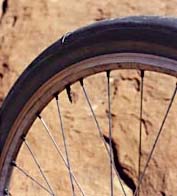 ride on, but don't let your tire slip off of one of these little platforms. Once your tire breaks loose the momentum will carry you down the side. Slick tires are a great help and some riders custom sew climbing shoe rubber onto old tire casings (see the story, LORD OF THE FLIES and our DREAMRIDE GUIDES SECTION). Avoid tires with any kind of siping. Tread is OK as long as it is carved INTO the tire, not raised ridges like the Ritchey Moabite slick that has a thin line of siping along the outside. Almost any tire will grab well enough to cling on a sidehill, but avoid weird compounds like those green Michelins! As for equipment considerations, the most beneficial aspects of the bike that help with sidehilling are a high bottom bracket and short crank arms. Small pedals help also. Anything that keeps you from banging a pedal is what you want.
ride on, but don't let your tire slip off of one of these little platforms. Once your tire breaks loose the momentum will carry you down the side. Slick tires are a great help and some riders custom sew climbing shoe rubber onto old tire casings (see the story, LORD OF THE FLIES and our DREAMRIDE GUIDES SECTION). Avoid tires with any kind of siping. Tread is OK as long as it is carved INTO the tire, not raised ridges like the Ritchey Moabite slick that has a thin line of siping along the outside. Almost any tire will grab well enough to cling on a sidehill, but avoid weird compounds like those green Michelins! As for equipment considerations, the most beneficial aspects of the bike that help with sidehilling are a high bottom bracket and short crank arms. Small pedals help also. Anything that keeps you from banging a pedal is what you want.
For a cheap and sleazy map of the Moab Slickrock Trail click on SLICKROCK TRAIL MAP. For a better map, buy MOUNTAIN BIKE MOAB by Lee Bridgers, published by Globe Pequot Press.

Call 1 (888) MOAB UTAH in the states.
If you are calling from foreign shores the number is 435-259-6419.
FAX number is 435-259-8196.
or write to:
DreamrideP.O. Box 1137
Moab, UT 84532
For email contact information click on:
CURRENT DREAMRIDE EMAIL ADDRESS
